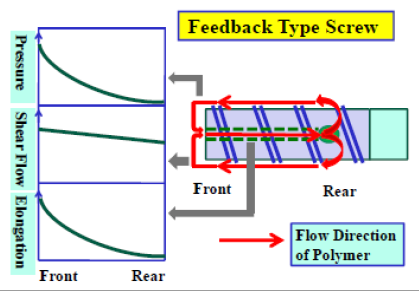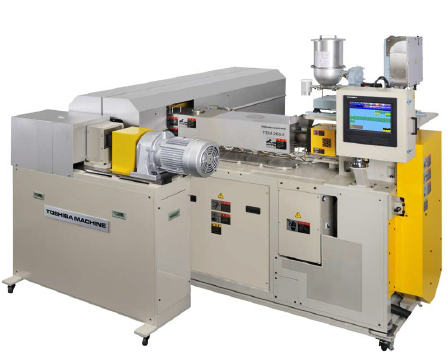Successful development of a nano-scale dispersion and mixing technique, high-shear processing, for fabrication of nano-composites
Dr. Hiroshi Shimizu (CEO of HSP Technologies Inc.) has developed a new polymer-blending technique using high-shear flow field, and succeeded in making miscible-polymer blends with nano-dispersion structures, when he was working in Advanced Industrial Science and Technologies (AIST). In this work, he has , for the first time in the world, realized nano-dispersion structures in polymer blends with a high-shear processing technique but without any additives; the dispersed domain sizes obtained are over smaller than the previous limit value. Furthermore, he found that the nano-structures can remarkably enhance the mechanical properties of the blends. The method is also considered to be useful for inorganic and/or organic dispersants such as carbon nanotubes, nano-particles, layered silicate, etc. and thus can be applied to medicines and cosmetics.
As shown in this figure, the feedback type screw loaded in the high-shear extruder can apply some external fields such as shear flow, elongation flow, and pressure, to the sample.

High-Shear Processing has the advantage of the formation of nanostructured materials
As shown in the following figure, high-shear processing can lead to the formation of the two kinds of typical nano-dispersion structures in which those structures are impossible for the usual extruder to achieve.
As shown in the upper side of the figure (Case 1), the phase separated structure is formed when using the usual extruder in which the domains of the dispersive phase with a size of several tens of micrometers are dispersed in the matrix phase, however high-shear processing can realize the formation of the nanostructured blends in immiscible polymer blend system, in which the domains with a size of several tens of nanometers are dispersed in the matrix phase.
Then, as shown in the lower side of the figure(Case 11), the aggregated structure is formed by using the usual extruder in which agglomerated fillers are located in the polymer matrix, however high-shear processing can realize the formation of the nanodispersed structure in which each filler defibrated is homogeneously and isotropically dispersed in the polymer matrix.
For example, the formation of nanostructure was verified in poly(vinyliden fluoride) (PVDF)/polyamide 11(PA11) blend and polycarbonate(PC)/poly(methyl methacrylate)(PMMA) blend, respectively using the high-shear processing in which these structures were corresponded to the Case 1. As the result, the nanostructure PVDF/PA11 blend exhibits improved electrical (ferroelectric and piezoelectric) and mechanical properties. The high-shear processed PC/PMMA blend exhibits excellent optical transparency due to the fine nanostructure.
On the other hand, the formation of nanodispersed structure was also verified in various nanocomposites such as polymer-carbon nanotube, polymer-carbonfiber, and polymer-clay systems by the high-shear processing in which those structures were corresponded to the Case 11. These kinds of polymer/filler nanocomposites exhibited improved electrical and mechanical properties.

Successful development of the extruder loaded with continuous type screw for mass-production
The high-shear extruder loaded with the batch type of screw can prepare nanostructured materials almost 1 kg per day. Then, our company succeeded in development of the high-shear extruder loaded with the continuous type of screw for mass production in collaboration with Toshiba Mashine Co. (press released on 25th April, 2014). The extruder for mass production can prepare up to 50 kg per hour at present. Two different type of screws are shown in the following figure.


